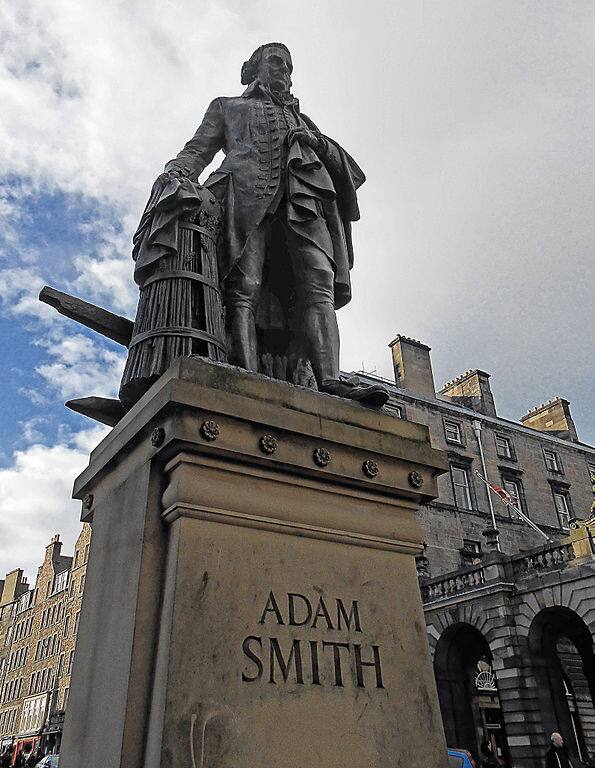



On June 5, 1723, Adam Smith, the Father of Modern Economics, was baptised in the town of Kirkcaldy (Scotland). As the world celebrates his 300th birth anniversary, let’s retrace his steps in Scotland and England.
Kirkcaldy, in Fife (Scotland)
Adam Smith was born in Kirkcaldy (Scotland), a small port roughly 10 miles from Edinburgh with a population of 1,500. His father died a few months before he was born, leaving the sickly young Adam to be raised by his mother Margaret Douglas. Smith’s exact date of birth is not recorded but he was baptised in Old Kirk on June 5, 1723, which is often celebrated as his birthday. He attended the local Kirkcaldy Burgh School (1729-37) where he studied mathematics, history, Latin and writing. Much later in life, he returned to Kirkcaldy where he wrote An Inquiry into the Nature & Causes of the Wealth of Nations (1776).
 Statue of Adam Smith on the Royal Mile, Edinburgh. (Photo via Wikimedia Commons)
Statue of Adam Smith on the Royal Mile, Edinburgh. (Photo via Wikimedia Commons)
What to see in Kirkcaldy
· Kirkcaldy's Links Market, Europe’s longest street fair, with over 200 fairground rides and attractions, is held each Easter on the town esplanade.
· Adam Smith Theatre
· In September this year, the Adam Smith Global Foundation exhibition centre will open to public. Housed on the site where Smith grew up at the east end of Kirkcaldy High Street, it will feature interactive exhibitions about the man as well as offices, meeting facilities and a timeline.
Glasgow: University of Glasgow
Smith entered Glasgow University (founded 1451) in 1737 at the early - but for the time not unusual - age of 14. His school-gained proficiency in the classics was such that he was effectively able to by-pass the early years in the curriculum devoted to Latin and Greek. In 1751, he returned to the University first as Professor of Logic and transferring to the Chair of Moral Philosophy shortly afterwards. Beyond courses in philosophy and jurisprudence, he also discoursed on history, literature, and language.
In 1764, he resigned his Glasgow professorship for the more lucrative post of tutor and companion to the 18-year-old Duke of Buccleuch. In a letter of thanks to the Glasgow University, Smith declared that he remembers his professorial days as ‘by far the most useful and therefore as by far the happiest and most honourable period of my life’.
As part of the University’s 300th anniversary celebrations, the University is launching a special summer school course titled Age and Ideas of Adam Smith.
What to see in Glasgow
· Glasgow Botanic Gardens
· Gallery of Modern Art
· The city has been given UNESCO City of Music status, head to the Glasgow Royal Concert Hall to catch a live performance.
· Riverside Museum & Tall Ship
· House of an Art Lover, a house designed by Charles Rennie Mackintosh
· The Burrell Collection & People’s Palace
Oxford: Balliol College
In July 1740, Smith, then 17, with a Snell scholarship in hand, left Glasgow to study classics and modern languages at Balliol College, Oxford. The journey to Oxford took him a month, on horseback. He wrote of the grandness of Oxford’s architecture and the fatness of its cattle, quite unlike the poor specimens in Scotland. Yet the English university education system did not impress him. He left Oxford in 1746, before the expiry of his scholarship, to return to Kirkcaldy. Today, a small bronze bust of Adam Smith, created by the distinguished Victorian sculptor Carlo Marochetti, is preserved in Balliol College.
What to see in Oxford
· Oxford University
· Bridge of Sighs
· Ashmolean Museum
· Carfax Tower
· River Thames Sightseeing Cruise
Edinburgh: Panmure House, The Royal Mile, Canongate Cemetery
Adam Smith moved to Panmure House in 1778 when he took up duties as a Commissioner of Customs. For the next 12 years, until his death in 1790, Panmure House was the centre of intellectual debate in Edinburgh.
The University of Edinburgh still has the collection from Adam Smith’s library comprising about 850 works in 1,600 volumes, including some treasures such as a fine copy of the first edition of Copernicus’ De revolutionibus (1543).
Smith died in the northern wing of Panmure House in Edinburgh on July 17, 1790, after a painful illness. His body was buried in the Canongate Kirkyard and the entry in the Old Parish Register for Canongate states that he was aged 68, and died of a decay. A bronze statue of Smith is outside St Giles Cathedral on the Royal Mile.
What to see in Edinburgh
· Edinburgh Castle
· Outlook Tower & Camera Obscura
· The Royal Mile
· Museum of Childhood
· Royal Botanic Garden
· Take time out for an underground ghost tour
· Day trip to Scottish Highlands, Loch Ness and Glen Coe
· Edinburgh Festival (August 4-28, 2023)
Smith on Currency Notes: Smith’s s photograph appears on the £50 note that has been issued since 2003 by Scotland's Clydesdale Bank. From Spring 2007, he appears on the Bank of England £20 note, the first Scotsman ever to have his photograph on a Bank of England note.
This is part 1 in a multi-part series on Adam Smith's tercentenary in June 2023.
Discover the latest Business News, Sensex, and Nifty updates. Obtain Personal Finance insights, tax queries, and expert opinions on Moneycontrol or download the Moneycontrol App to stay updated!